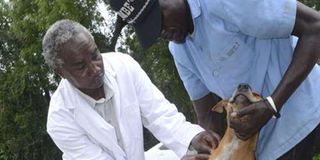We must tackle neglected diseases

An animal health assistant injects a dog with a rabies vaccine in Mombasa on November 8, 2013. PHOTO | KEVIN ODIT | NATION MEDIA GROUP
What you need to know:
High-profile health challenges such as HIV, malaria and tuberculosis will continue to attract the big money from international donors.
But other diseases such as rabies, elephantiasis and trachoma that maim, blind, disfigure and even kill Kenyans every year will have to be tackled by us alone.
We must take responsibility for ourselves and commit to restoring health and dignity to our people.
We have always known that some animal diseases can jump species and infect man, but the current figures are startling. Today we know that over 60 per cent of all pathogens that infect humans have their origins in animals, and that the figure rises to 75 per cent for emerging diseases. The worry is that once diseases such as Ebola, Zika, swine and avian flu have jumped from animals to humans, they will spread quickly between people.
For this reason, these diseases attract the most international attention with donor funding following in hot pursuit. Large sums of money are given in response to these high-profile outbreaks not only to protect people in the affected regions, such as sub-Saharan Africa, but also to keep the disease from spreading to the countries from which the donor funds come.
Similar funding enthusiasm is lacking for many other diseases that have a huge burden on people living in poor rural areas but little potential to spread beyond the country affected. These are known to affect more than 1 billion people around the world.
A good example is rabies, a disease that kills 2,000 Kenyans every year. It is a terrible way to die, and it can be devastating for family members to witness their loved ones descend into madness. What’s worse is that rabies is preventable. Almost all cases in people are the result of untreated bites from rabid dogs. If we vaccinate dogs we can go a long way to keeping humans free from risk of rabies infection.
VETERINARY SECTOR
This is, however, only possible if counties invest in their veterinary sector and undertake a systematic programme of dog vaccination. It makes sense both in terms of public health and economics.
Unlike other infectious diseases, such as polio, that require almost 100 per cent of children to be vaccinated, only 70 per cent (around 3.5 million animals in Kenya) of the dog population needs to be vaccinated annually for three years to eradicate rabies in dogs altogether, and consequently keep the disease away from humans.
The cost of vaccinating a dog is less than Sh100, whereas the cost of a full dose of vaccinations for a person bitten by a suspected rabid dog is easily Sh10,000. Without these post-exposure vaccinations, all victims of rabies disease die a cruel death. Many counties in Kenya report 5,000 or more dog bites per year and continue to spend huge amounts of money on the human vaccine. But they spend nearly nothing on vaccinating dogs where the disease originates and where it is easiest to control.
Kenya has made a commitment to end rabies by 2030, and is leading Africa in this quest. A rabies elimination strategy for Kenya has been launched, a National Rabies Elimination Coordination body is in place, and some counties such as Makueni have started vaccinating their dogs.
Although this is an encouraging start for rabies, its elimination is dependent on the county governments investing in mass dog vaccinations that will save the lives of its voters.
High-profile health challenges such as HIV, malaria and tuberculosis will continue to attract the big money from international donors. But other diseases such as rabies, elephantiasis and trachoma that maim, blind, disfigure and even kill Kenyans every year will have to be tackled by us alone. We must take responsibility for ourselves and commit to restoring health and dignity to our people.
Thumbi Mwangi is a Wellcome Trust Fellow at the Kenya Medical Research Centre, a lecturer at Washington State University in the US and a 2016 Aspen New Voices Fellow.




